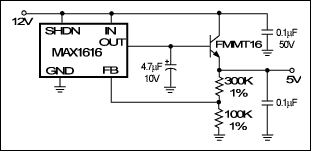利用射极跟随器提升线性稳压器的输出电流,Emitter-Follower Boosts Linear Regulator's Output Current
AddiTIonal InformaTIon:
- Quick View Data Sheet for the MAX1616
- Technical Support: Power
AutomoTIve electronics often require memory for saving system informaTIon or for user inputs (the settings on a car stereo, for example). Flash memory can do the job, but flash is expensive. Though DRAM memory reduces the cost, DRAM requires an always-on power supply. A standard linear regulator, such as the LM78L05, can generate the 5V rail required for 5V DRAM, but its supply current (as much as 5mA) can discharge the battery over an extended period of inactivity.
On the other hand, linear regulators with low quiescent current may not have sufficient load-current capability to supply the DRAM during active read or write operations. The design solution in this situation is to add an emitter-follower output stage to a low-current high-voltage low-dropout (LDO) regulator (see the figure below). Adding the transistor as shown, between the LDO output and load, increases the available output current without boosting the regulator's low (15µA) quiescent current.
Though not an issue for the application in question (regulating a 12V battery down to 5V), the dropout voltage (minimum-allowed VIN minus VOUT) for this circuit equals that of the regulator IC (350mV maximum) plus the transistor's base-emitter drop of approximately 0.7V. The pass element in IC1 is a pnp transistor, whose saturation at low dropout voltage increases the quiescent current for that condition. To maintain low quiescent current, therefore, the regulator headroom should be kept well above 1V.
Figure 1. An external emitter-follower increases the output current while maintaining the low quiescent current of this LDO regulator.
A similar version of this article appeared in the June 26, 2000 issue of Electronic Design.